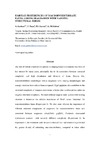Identificador persistente para citar o vincular este elemento:
https://accedacris.ulpgc.es/jspui/handle/10553/9825
| Título: | Habitat preferences of macroinvertebrate fauna among seagrasses with varying structural forms | Autores/as: | Gartner, A. Tuya, F. Lavery, P. S. McMahon, K. |
Clasificación UNESCO: | 2401 Biología animal (zoología) 241713 Ecología vegetal |
Palabras clave: | Structural complexity Macroinvertebrate fauna Seagrass Western Australia Canary Islands |
Fecha de publicación: | 2013 | Publicación seriada: | Journal of Experimental Marine Biology and Ecology | Resumen: | The role of habitat structural complexity in shaping faunal communities has been of key interest to marine ecologists for many years, principally due to the association between increased complexity and high abundances and diversity of fauna. Despite this, macroinvertebrate assemblages within seagrasses with varying morphologies and canopy structures have seldom been compared. Algal epiphytes also contribute to the structural complexity of seagrass ecosystems, a factor often overlooked in studies on seagrass structural complexity. We used artificial seagrass units (ASUs) with varying structure to determine the relative importance of food versus structure for macroinvertebrate fauna (Experiment 1). We also tested whether the importance of different structural components of seagrasses for macroinvertebrate fauna was consistent between seagrasses (Amphibolis griffithii, Posidonia sinuosa and Cymodocea nodosa) with naturally different complexity (Experiment 2). In Experiment I, the treatments with the combination of food and structure together had the greater density of colonizing macroinvertebrates, compared to those where either structure or food were independently tested. In Experiment 2, the density of fauna colonizing ASUs varied among complexities of ASUs, as well as seagrasses. When ASU's were placed alongside A. griffithii and P. sinuosa (species which vary greatly in morphology, but little in available surface area) the highest densities of fauna were generally found on ASUs with artificial epiphytes. This suggests-that small-scale variation in structure was more important than large-scale variation in canopy morphology. However, there was no difference in the total density of fauna colonizing onto ASUs placed alongside C. nodose, which morphologically has a structure similar to P. sinuosa, but much lower surface area. We conclude from these experiments that the effect of high structural complexity in seagrasses is an important driver of macroinvertebrate density, in particular, that provided by algal epiphytes. However, the effect of structural complexity may be reduced when seagrass canopy surface area is limited. (C) 2012 Elsevier B.V. All rights reserved. | URI: | https://accedacris.ulpgc.es/handle/10553/9825 | ISSN: | 0022-0981 | DOI: | 10.1016/j.jembe.2012.11.009 | Fuente: | Journal of Experimental Marine Biology and Ecology[ISSN 0022-0981],v. 439, p. 143-151 | Derechos: | by-nc-nd |
| Colección: | Artículos |
Citas SCOPUSTM
88
actualizado el 08-jun-2025
Citas de WEB OF SCIENCETM
Citations
85
actualizado el 08-jun-2025
Visitas
69
actualizado el 03-feb-2024
Descargas
313
actualizado el 03-feb-2024
Google ScholarTM
Verifica
Altmetric
Comparte
Exporta metadatos
Los elementos en ULPGC accedaCRIS están protegidos por derechos de autor con todos los derechos reservados, a menos que se indique lo contrario.
